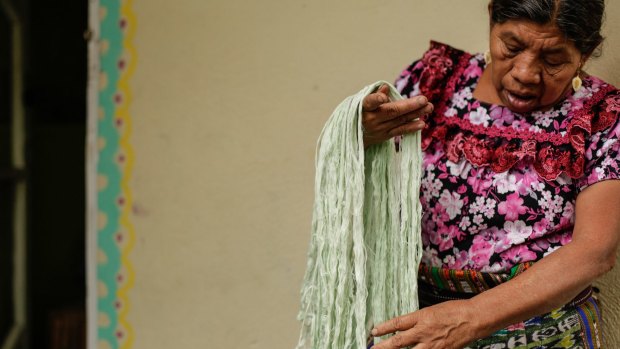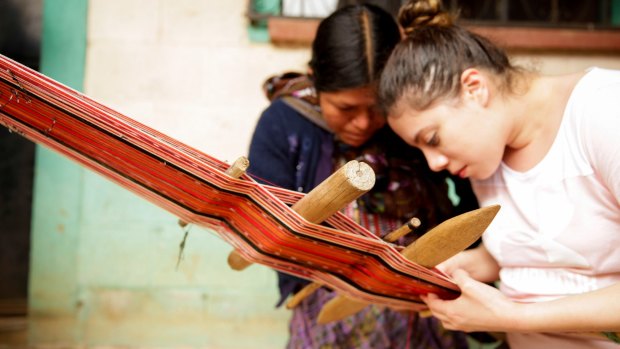This was published 4 years ago
Traditional weaving in Guatemala: Keeping a dying art alive
By Nina Karnikowski

Weaving is one of Guatemala's most important cultural traditions - but it's under threat.Credit: Paula Harding/Thread Caravan
It is a sunny Monday morning in Chuacruz village in the mountains by Guatemala's Lake Atitlan, and on the tiled floor of a turquoise-coloured adobe building a wizened Mayan woman is teaching our group of eleven foreign women how to spin raw cotton.
She takes the wooden spindle in her right hand and the local brown ixcaco cotton - which we have just watched her de-seed by hand and then beat with wooden sticks to meld the fibres together – in her left.
Effortlessly, she twists the spindle like a spinning top, and a thin thread of cotton gently wraps around it.

It's not as easy as it might look.Credit: Paula Harding/Thread Caravan
It is an arduous and ancient process, one that has changed little since this woman's ancestors discovered it in pre-Colombian times.
It is also, we learn as this first of our five-day weaving workshop with creative travel company Thread Caravan unfolds, the first of many steps towards transforming this cotton into the intricately woven, riotously coloured traditional costume that women all around the country still wear today.
As we take turns trying (clumsily, and mostly unsuccessfully) to spin the cotton, Thread Caravan's founder, 29-year-old American Caitlin Garcia-Ahern, tells us that each piece of clothing the women here are wearing, including the embroidered huipile blouses, full-length skirts, vibrant sashes and head wraps, is a one-of-a-kind artwork.
The shades, patterns and materials vary from village to village, she says, rendering the garments a proud representation of the wearer's hometown roots. But, despite these weaving traditions being integral to Guatemala's history and national identity, Ahern says they are in danger of extinction.
"Guatemalan women who wear traditional clothes these days are often seen as less educated and are discriminated against," she says softly as we watch one of the women weave an elaborate pattern on a loom.
"These items take time to create - up to two months, sometimes - plus they're expensive. And since there are now 15 tonnes of cheap, second-hand clothes being sent here from America every month, why would the younger generation spend the time and money weaving something when they can just buy a T-shirt for a dollar?"
This is precisely why Ahern has brought us to this local co-operative. It's her way of participating in the fight to keep Guatemala's weaving traditions alive, and of helping to ensure that the older women in the communities, many of whom lost their husbands, brothers and fathers during Guatemala's bloody 30 year civil war, continue to generate income from their craft.
The following morning we awake at our home for the next four days, a collection of ethnic-chic villas set on the steep shores of Lake Atitlán in Guatemala's southwestern highlands.
As we sip local coffee in the garden, hummingbirds hover over the yellow and red clock vine flowers hanging from the veranda, and the morning mists dissolve to reveal the three colossal volcanoes fringing the lake.
Lake Atitlán is also surrounded by Mayan villages, and soon a small boat arrives to deliver us to one of them, San Juan la Laguna.
From the dock we weave through the cobbled laneways, past adobe houses the colour of fairy floss and fair-trade shops selling honey, coffee and textiles, to a small natural dyeing co-operative.
Here we meet local Rosalinda Tay, a woman who has dedicated her life to working with natural dyeing processes and preserving them for future generations.
Tay ushers us into a greenhouse, where wooden trellises are hung with cactus pads that look like they're dusted with icing sugar.
But this white powder, she tells us via a translator in her native Tz'utujil Mayan language, is actually tiny insects called cochineal that feed off the cactus.
Once they reach the end of their three-month lifespan they are carefully brushed off the cactus, ground, boiled, and finally used as a natural dye.
Back outside in the garden courtyard we watch Tay grind the cochineal into a crimson-coloured powder, then spend the afternoon dyeing skeins of cotton with it and marvelling at the ingenuity of whoever discovered this process.
While the future of Guatemala's weaving traditions is uncertain, for now they remain delightfully present, almost everywhere we look.
We spend the next morning in San Antonio Palopó village with a group of local weaving instructors learning the basics of designing and setting up a weaving.
I'm paired with a woman named Francisca who, as she helps me wrap my chosen coloured cottons around the warp board, tells me she has been weaving for 40 years and that she has taught all four of her children to weave.
That afternoon, as our group hikes through nearby terraced farmland, we watch farmers till their fields in bright hand-woven shirts and trousers.
Later, as we bump back to our villas in the back of a Jeep, we pass a town full of blue buildings painted with the exact same designs we've seen woven into the local's clothing.
On our last full day on Lake Atitlan, we're finally ready to start weaving. Sitting in the gardens surrounding our villas and with the help of the local weavers, we set up our backstrap looms.
Francisca attaches one end of mine to a post and the other around my back, then shows me how to pass the wooden shuttle back and forth between the strings of cotton.
At first it's a slow and awkward process. Soon, though, I slip into a rhythm and it becomes almost meditative, my mind growing clear and calm.
The day passes quickly and before I know it, the sun is setting and my weaving is finished. I hold the 30-centimetre piece of fabric in my hands, disproportionately proud.
Will I return home a master weaver? Certainly not. But this little weaving symbolises everything I have learnt about one of Guatemala's most important cultural traditions and, having taken five days to create it, I know I'll never look at any piece of clothing the same way again – especially those shoddy dollar t-shirts.
And that, I decide as I stand in the delicate twilight, is more than enough for me.
TRIP NOTES
EXPERIENCE
Thread Caravan runs multi-day cultural art workshops in Guatemala, Mexico and Panama covering ceramics, weaving, embroidery and more. The next six-night Guatemala textile workshop runs December 8-14, and costs $3,450 ($2,400 USD). See threadcaravan.com.
FLY
Air New Zealand flies to Houston up to five times a week via Auckland from Sydney, Melbourne, Brisbane, Adelaide, Perth, the Sunshine Coast and Coolangatta. From there, it's a two-hour 40-minute flight to Guatemala City. See airnewzealand.com.au.
MORE
FIVE MORE GUATEMALAN CULTURAL EXPERIENCES
TAKE A JADE WORKSHOP
The ancient Mayans were one of the world's biggest jade producers and it remains an important part of Guatemalan identity. Learn more about it as you design and create a piece of jade jewellery at a local Antiguan workshop. See threadcaravan.com.
EXPLORE THE TIKAL RUINS
Set in northern Guatemala, these ruins were once a city and ceremonial centre for the ancient Mayans, inhabited from the 6th century BC. Explore the temples, palaces and public squares, ideally at sunrise.
DO A FOOD TOUR
Let passionate young Guatemalan chef Rebeca de León tell you the stories behind each dish you taste during her Antigua-based cooking classes and food tours, which promote Guatemala's culinary heritage. See kukultales.com.
VISIT LA NUEVA FABRICA
This new art centre, set in an erstwhile Antiguan textile factory, hosts contemporary art and photography exhibitions, workshops, lectures, concerts and an artist's residency program. See newrootsfoundation.org.
DISCOVER CHICHICASTENANGO MARKET
Take the two-hour bus ride from Antigua to Chichicastenango on Thursday or Sunday to experience one of Latin America's best markets, selling textiles, masks, pottery and more.
Nina Karnikowski was a guest of Thread Caravan.
Sign up for the Traveller Deals newsletter
Get exclusive travel deals delivered straight to your inbox. Sign up now.